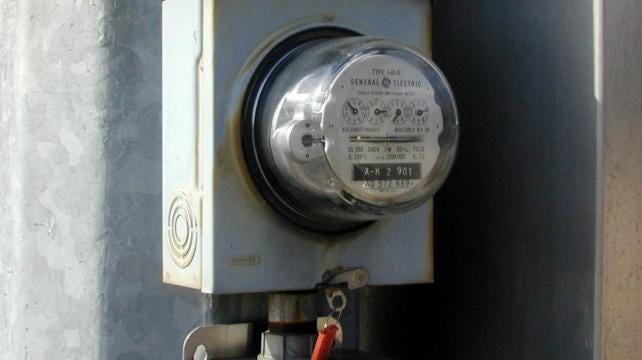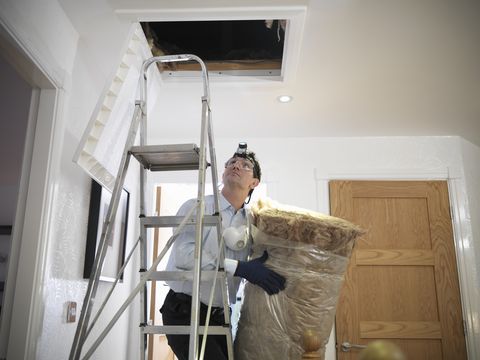How to make your home more energy efficient – Good Housekeeping
Energy Disrupter
If ever there were a time to give your home an energy efficiency makeover, this is it – for the sake of the planet, as well as your bank balance.
The soaring cost of household energy has made most of us scrutinise our use of gas and electricity and look at the energy efficiency of our homes in a different light – or maybe even consider it for the first time.
Making improvements to boost your home’s energy efficiency could reduce energy bills, cut its carbon footprint and even – as new research shows – increase its value and appeal to future buyers. A recent survey from Admiral Insurance reveals that three quarters of Brits (76%) are influenced by energy-saving features when buying a property and a quarter would pay more for homes with an EPC rating of C or higher (see boxout).
The cost of energy efficient home improvements can range from tens to thousands of pounds – but which are the projects worth spending on to reduce energy use and save money in the long-run? We’ve rounded up the figures you need to make an informed decision.
What’s the best way to insulate my home?
Insulating hot water pipes and your hot water cylinder (if you have one) is cheap and will pay for itself quickly. The Energy Saving Trust (EST) estimates that fitting foam insulation around exposed hot water pipes and increasing the thickness of insulation around your hot water cylinder to 80mm costs just over £30 but could shave almost £80 off your yearly energy bills.
Having cavity walls insulated is a pricier project (around £1,000 for a three-bed semi-detached house) but as roughly a third of the heat in our homes is lost through the walls, you should see an annual saving of just under £400 on your energy bills.
Is it worth draught-proofing my home?
If you’re looking for a quick, budget-friendly, energy-efficient fix, fitting a chimney draught excluder such as a Chimney Sheep (from £18) above an unused fireplace could slash £90 from your energy bill over 12 months.
Draught-proofing windows and doors could also cut energy bills. If you choose to have your home professionally draft proofed, you can expect to pay around £233 for a three-bed semi-detached house but this should pay for itself in less than two years.
What’s the best way to control the central heating?
In addition to trying to reduce the amount of heat lost from your home, making better use of your central heating can also cut energy use. Installing a thermostat, programmer and thermostatic radiator valves (that regulate the temperature of individual radiators) in a typical semi-detached home will cost around £580 and could result in annual savings of £180. If you already have a thermostat and programmer, installing thermostatic radiator valves on radiators that don’t already have them (they cost from £10 each) in a home of this size could save £55 a year.
If you already have all these things in place, a smart thermostat such as those from tado (tado.com; from £199.99 for a wireless thermostat) could cut the energy you use to heat your home by around a quarter.
Should I invest in solar panels?
If you’ve been put off solar panels by lengthy payback times, now could be the time to reconsider, as higher electricity prices mean you’ll see a faster return on your investment. Analysis by the climate and energy website Carbon Brief shows that the payback time for a typical domestic rooftop solar installation is roughly half what it was two years ago. This is based on a fairly typical 3kWp solar panel system costing £4,320 (the price takes into account the fact you won’t pay VAT on solar panels at the moment) and assumes you sell some of the excess electricity you generate back to the national grid. Today, a system like this would pay for itself in around nine years, compared to 20 years in October 2020.
‘For those that can afford the initial outlay, solar panels are a great way to insulate yourself against high and volatile fossil fuel prices and they will also cut your carbon emissions,’ notes Dr Simon Evans, senior policy editor of Carbon Brief. ‘We don’t know how long this energy crisis will continue but it’s widely expected that gas prices – which drive the price of electricity – will remain high for much of this decade.’
The savings you stand to make on your annual electricity bill depend on a number of factors, including how many people in your household are at home during the day to use the energy generated and where in the UK you live. Figures from the EST show that if you live in South-East England and someone’s at home all day, you could save around £610 a year on electricity if you sell some of the power you generate. You’d save £580 in Abersytwyth and £545 in Stirling but only £235 in Belfast.
If you’re interested in getting solar panels installed in your home, get at least three quotes from the list of qualified solar installers on the MCS website.
Do I need a heat pump?
Air source heat pumps use heat from the air outside to heat your home and hot water, and are a key part of the government’s plans to cut the carbon footprint of our homes. Costing £7,000-£13,000, they don’t come cheap, and you may need to pay extra for additional work to fit a hot water cylinder (standard pumps don’t heat water on demand) or upgrade your radiators, for example. If you live in England and Wales, however, you could be eligible for a government grant of £5,000 through the Boiler Upgrade Scheme, which your installer will apply for on your behalf.
Having a heat pump installed will certainly cut your home’s carbon emissions – but will it cut your energy bills? This depends on the type of heating system you currently have and where you live. If you live in England, Scotland or Wales in a three-bedroom, detached home and you’re replacing an old gas boiler with an energy efficiency rating of G, EST estimates that you stand to save around £395 a year on your gas bill. However, if you currently have an A-rated gas boiler, you’re actually likely to pay slightly more if you have an air source heat pump installed. If the same home were heated solely using electric storage heaters of any kind, you’d be looking at an annual saving of £890-£1,500 on your annual energy bills.
Energy Performance Certificates explained
An Energy Performance Certificate (EPG) gives your home a rating to show how energy efficient it is. This ranges from A (efficient) to G (inefficient). If you’re selling your home, you’ll need to make its EPG available to potential buyers. If your home doesn’t already have an EPG, getting one from an accredited assessor can cost up to £120. The certificate will be valid for 10 years from the date of issue. If you think your home may already have an EPG, you can search for it on the government’s website.
As well as giving your home an energy efficiency rating, the EPG also sets out a list of recommended energy-saving home improvements tailored to your property, with estimated costs and savings, to help boost its rating. If your home doesn’t have an EPG and you’re not planning on selling up in the near future, you can get free advice on next steps you could take to make it more energy efficient at gov.uk.
Unless otherwise stated, all figures are from the EST and are calculated based on the October 2022 Energy Price Guarantee.


















